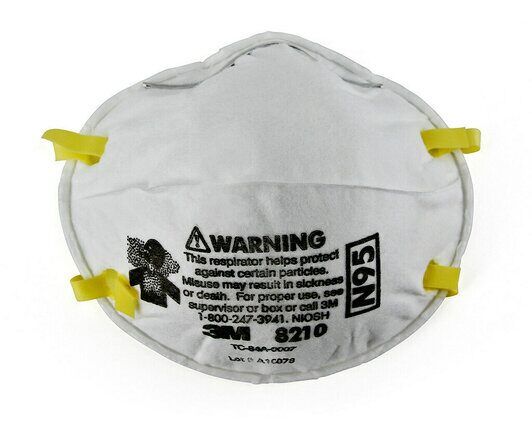Medical Masks Or N95s For COVID-19 Protection in Health Care?
Although medical masks were noninferior to N95 in a multinational study of frontline health care workers, variability in circumstances between countries prevented researchers from drawing firm conclusions.

In health care settings, workers typically don either medical masks, also called surgical masks, or N95s when interacting with patients. The World Health Organization recommends medical masks during routine patient care for the prevention of COVID-19, while the Centers for Disease Control and Prevention suggests N95 masks. It is unknown whether the masks offer equal levels of protection against COVID-19, as studies involving other respiratory viruses have yielded varying results.
To address this, a team of scientists at Canada’s McMaster University designed a randomized study to determine if medical masks are noninferior to N95s. A total of 1009 health care workers across Canada, Israel, Pakistan, and Egypt were randomized to wear either medical masks or N95s when interacting with patients with confirmed or suspected COVID-19 infections. The study was conducted at 29 different health care facilities, including 17 acute care hospitals in Canada, 6 acute care hospitals in Egypt, 4 acute care hospitals in Pakistan, and 2 long-term care facilities in Israel. The study ran from May 2020 to March 2022, and the primary outcome was the time it took for subjects to receive a PCR-confirmed COVID-19 test.
The initial subjects were unvaccinated; as the trial progressed and vaccines became available, some participants received 1 or more doses of mRNA vaccines. The subjects were assessed for COVID-19 seropositivity at baseline and then followed for 10 weeks, or 2 weeks after their first mRNA vaccine if that applied. They were required to use masks at all times while inside their health care facilities. When participants were involved in aerosol-generating procedures, all were required to use N95s no matter which mask cohort they were in.
Participants received twice-a-week texts asking them to describe any signs and symptoms of COVID-19 they might be experiencing. They were given a nasopharyngeal swab to test for COVID-19 if they had 1 of the following: a fever of at least 38 degrees C (100.4 F), a cough, or shortness of breath, or 2 of the following: dizziness, fatigue, muscle aches, headaches, vomiting, mucus expectoration, sore throat, diarrhea, stomach pain, runny nose, change in taste and smell, conjunctivitis, or painful swallowing.
During the trial, documented COVID-19 infections occurred in 52 out of 497 (10.46%) participants in the medical-mask cohort vs. 47 out of 507 (9.27%) in the N95 cohort, with a hazard ratio (HR) of 1.14 [95% confidence interval (CI), 0.77 - 1.69]. By country, the results were as follows: In Canada, COVID-19 was diagnosed in 8 out of 131 (6.11%) in the medical-mask group vs. 3 out of 135 (2.22%) in the N95 group (HR = 2.83 [CI 0.75 - 10.72]); in Israel, infections occurred in 6 out of 17 (35.29%) medical-mask wearers vs. 4 out of 17 (23.53%) N95 wearers (HR = 1.54 [CI 0.43 - 5.49]); in Pakistan, it occurred in 3 out of 92 (3.26%) in the medical-mask cohort vs. 2 out of 94 (2.13%) in the N95 cohort (HR = 1.50 [CI 0.25 - 8.98]); and in Egypt, it occurred in 35 out of 257 (13.62%) medical-mask wearers vs. 38 out of 261 (14.56%) N95 wearers (HR = 0.95 [CI 0.60 - 1.50]).
The variability of medical-mask protection rates vs. N95 protection rates by country does not appear to stem from different baseline seropositivity rates, according to the authors, who explained that a separate analysis involving only participants seronegative at baseline yielded comparable results. It’s possible that differing starting dates impacted the findings; in Canada, for instance, enrollment began early in the pandemic, presumably before many people had a chance to become infected. Pakistan and Egypt joined the study much later, after many participants already had been exposed to the virus.
Participant numbers also varied by country, with Israel accounting for 34 subjects while Egypt accounted for 518. These enrollment differences could have impacted results. For instance, the fact that 6.11% of subjects in Canada who wore medical masks contracted COVID-19 vs. 2.22% who wore the N95 suggests a nearly threefold increase in risk; however, Canada’s relatively small enrollment numbers make it difficult to draw firm conclusions. Varying rates of community transmission in different nations also may have affected results.
Ultimately, the study’s findings were inconclusive and perhaps raised more questions than they answered. “[A]lthough the upper limit of the CIs of the pooled estimate for medical masks when compared with N95 respirators for preventing RT-PCR-confirmed COVID-19 was within the noninferiority margin of 2, this margin was wide, and firm conclusions about noninferiority may not be applicable given the between-country heterogeneity,” the authors wrote.
The full study was published in the Annals of Internal Medicine.
